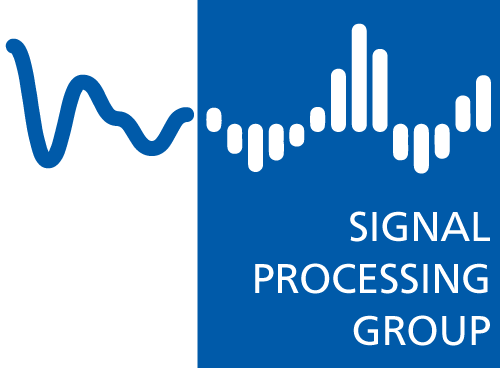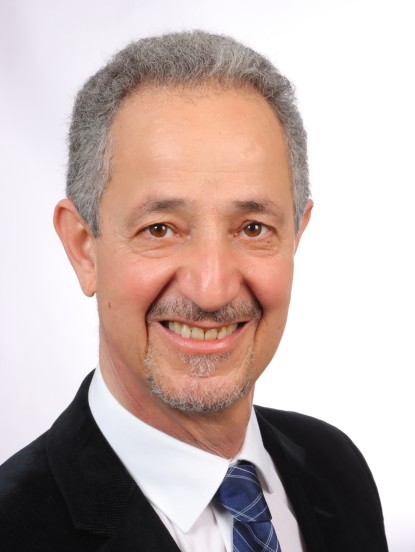Introduction
Whilst a few decades ago cars were viewed as purely mechanical devices, today's new models contain increasingly sophisticated electrical devices. As this trend continues, there will be more and more signal processing going into the development of the vehicles of tomorrow.
Advanced signal processing techniques are already being used in several areas of the automotive industry, including, but not limited to:
* Engine control and monitoring -- e.g. detection of knock
* Parking assistance/Autonomous navigation -- sensors and systems to create environmental awareness and to assist the driver in entering a parking place
* Modern driver assistance systems -- radar sensors measure the environment and allow applications such as adaptive cruise control or lane change assistant
* Active safety -- systems that detect dangerous situations and can alert the driver to potential dangers and/or induce procedures to avoid or alleviate the crash
DOA Estimation for Automotive Radar
A radar array system can be used to determine the range, relative velocity and direction-of-arrival (DOA) of objects in a car environment. These measurements are required by modern driver assistance systems such as adaptive cruise control (ACC) or lane-change assistant (LCA).
We focus on the DOA estimation problem by means of phase differences, which are received at the array elements. In the mentioned applications, there are some special scenarios where conventional DOA estimation fails to resolve closely spaced targets and high-resolution methods become necessary. Often this corresponds to the occurance of specular multipath with the guard-rail.
High-resolution methods are generally computationally more demanding and thus may not be straightforwardly applicable for a system with real-time constraints. Clever selection strategies and computational simplifications are subject of current research.
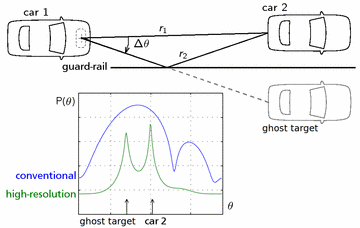
Acoustic Imaging for Safety and Comfort Applications
The use of sensor arrays is investigated for 3D acoustic imaging applications such as autonomous navigation (e.g. robots) and safety applications (e.g. obstacle detection and classification for collision avoidance). The aim is to advance the rather simple approaches of existing sensors, e.g. simple range measurements, to create environmental awareness of mobile platforms such as a robot independent of lighting conditions and expensive hardware.
While acoustic arrays have been successfully used for imaging in medical, material or underwater sonar applications, their use in air is still limited due to physical restrictions, i.e. slow speed of propagation and high attenuation. However, for short-range applications such as autonomous navigation robots, they offer a cheap, reliable and low power alternative to optical or lidar/radar sensors while providing discrimination between close objects and background (in contrast to optical sensors). In this context, acoustic imaging can be viewed as a valuable sensor modality that may extend the capabilities of a system with relatively small effort. Additionally, acoustic imaging allows to detect the presence of persons in the environment based on relatively simple features from the acoustic images. To a limited extend, it is even possible to classify the posture of the human, e.g., whether he or she is standing or walking, already from single images.
The primary goal is to obtain a three-dimensional map of the scene that surrounds the platform. To achieve this, the development of fast algorithms to obtain high-quality images, allowing for multiple, spatially extended, highly correlated sources is of importance. Moreover, the optimization of the sensor array layout with respect to the no. of elements, noise suppression and resolution of object contours, and the detection and classification of objects, their position, surface structure and (possibly) shape is subject of current research.
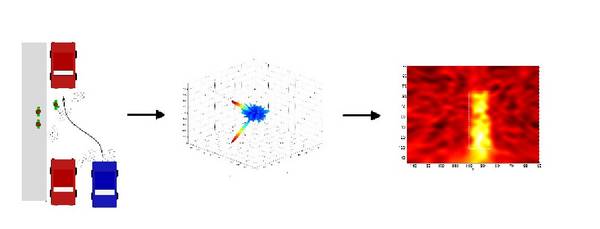
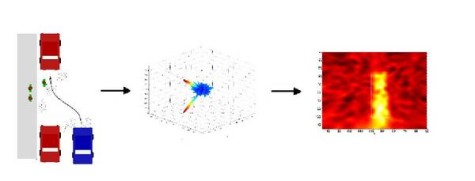
Introductory Literature
- H. Winner, S. Hakuli, G. Wolf, Handbuch Fahrerassistenzsysteme – Grundlagen, Komponenten und Systeme für aktive Sicherheit und Komfort, Vieweg+Teubner 2009
- T. Tuncer, B. Friedlander, Classical and Modern Direction-of-Arrival Estimation, Academic Press 2009.
SPG Publications
- P. Heidenreich, D. Stenmanns, A. Zoubir, Computationally Simple Criteria for Detecting a Multi-Target Scenario in Automotive Radar Array Processing, EUSIPCO 2010.
- M. Moebus, M. Viberg and A. Zoubir, Parametrization of Acoustic Images for the Detection of Human Presence by Mobile Platforms, ICASSP 2010.
- P. Heidenreich, A. Zoubir, High-Resolution Direction Finding of Coherent Sources in the Presence of Model Errors using Alternating Projections, SSP Workshop 2009.
- M. Moebus and A. Zoubir, Three-Dimensional Ultra-Sound Imaging In Air For Parking And Pedestrian Protection, bookchapter in “Vehicle Corpus and Signal Processing for Driver Behavior”, Springer 2008.

